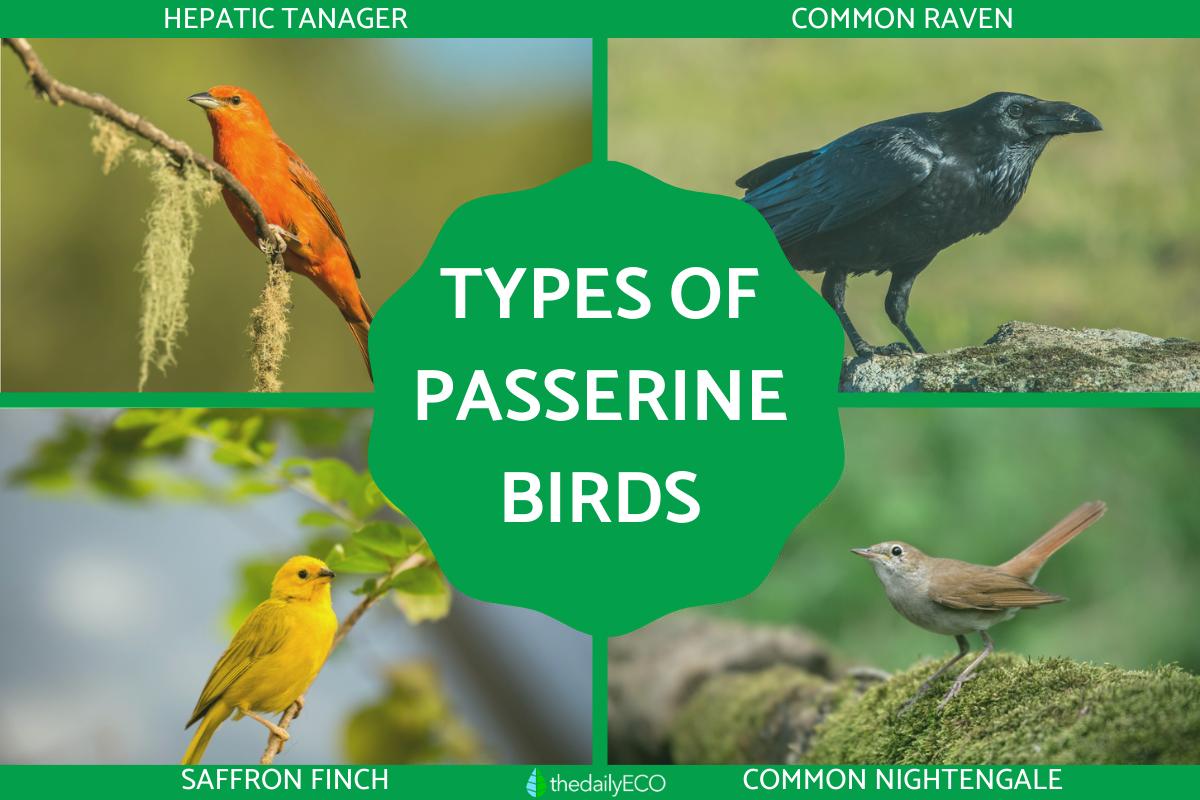What Are Passerine Birds? - Definition and Types


Passerines are commonly known as perching birds. They are the birds which make up the order known as Passeriformes. Within this order is a great diversity of birds, but they all have certain traits in common. Specifically, they have an arrangement of their feet which make it easier for them to perch on trees and other objects. They are one of the most abundant and diverse of all types of bird, making up more than half of all avian species. Despite the large amount of Passerine birds, they are mainly made up of smaller birds.
At thedailyECO, we ask what are passerine birds? To answer this question, we provide a definition of passerines, as well as examples of the different types of passerine birds that exist with photos.
What are passerine birds?
The very basic definition of passerine birds is any bird that is part of the order Passeriformes. These are birds which are usually small in size, although there is also great diversity in their morphology. We have already stated that passerines are the largest of all bird orders, compromising around 60% of all known bird species in the world. Their evolutionary success has allowed them to adapt to environments as different as deserts and tropical rainforests.
The order Passeriformes is subdivided into three separate suborders. They are:
- Passeri: commonly known as songbirds with well-developed vocal organs.
- Tyranni: while they have birdsong, their song structures are less developed and live in the Neotropics.
- Acanthisitti: very small birds which are endemic to New Zealand.
All of the members of these suborders share certain characteristics common to passerine birds. We can see the specifics of these passerine characteristics in the next section. Learn more about the taxonomic rankings of all birds with our article on how are birds classified?

Characteristics of passerine birds
With such a great diversity of species, there are many differences between each passerine bird. It can be a little more difficult to see their similarities, but the following are considered the common characteristics of passerine birds:
- Feet: the characteristic of passerines which gives them their common name is the amount and placement of their toes. Perhaps the defining trait of passerines is having four toes on each foot with three directed towards the front and one direct towards the back. This is known as an anisodactyl arrangement of toes and it is the reason they are known as perching birds since it allows better purchase on various surfaces.
- Size: passerines are generally small in size. THe vast majority are less than 12"/30 cm long, with the exception of the red-ruffed fruitcrow (Pyroderus scutatus), certain magpies (Pica spp.) and crows (Corvus spp.).
- Hallux: the hind toe of passerine birds is known as the hallux. It has a tendon attached to it which is capable of stretching and tightening when the leg is bent. This also helps them to perch better on tree branches and other places without falling.
- Webs: they do not have interdigital webbing on their feet, nor do they have joints between them.
- Feathers: most have 12 tail feathers and 8-9 flight feathers on the wings.
- Vocalizations: most types of passerine birds sing, not only those of the songbird suborder. This is due to the presence of a complex system of muscles that control the syrinx (i.e. the vocal organ). Its song is used for communication, courtship and the delimitation of territories.
- Nests: passerines create elaborate nests using a wide variety of resources such as twigs, mud, leaves, feathers and other materials.
- Young: their eggs are colorful and the chicks that hatch from them are altricial. This means they rely on their parents for survival since they are naked and blind at birth.
Find out about other types of birds in our article comparing the differences between swallows, swifts and martins.
Types of passerine birds
Now we know the definition and characteristics of passerine birds, we can look at some examples in the animal kingdom. Below are some characteristic types of passerines with photos at the bottom to see how they compare to each other:
- Hepatic tanager (Piranga flava): it is a bird that presents marked sexual dimorphism, with the male being fiery red and the female being yellow with an olive-colored back. The tanager in the photo below is male. It is distributed from the southwestern United States to South America. It is usually observed in open forests and savannahs.
- Red-crested cardinal (Paroaria coronata): this passerine bird is easy to distinguish due to its striking red crest. Cardinals are distributed in South America and have a very melodious song. They usually live in pairs or flocks. Unfortunately, they are threatened by fragmentation and loss of habitat, as well as by illegal hunting and commercialization.
- Blue manakin (Chiroxiphia caudata): inhabitant of central-eastern South America, the blue manakin is a bird that also presents great sexual dimorphism. The male is intense blue with black wings and a red crown, while the female is olive color. It is the male blue manakin depicted in the photo below. These birds form form leks, groups of males who sing and dance when courting the females.
- Short-tailed pygmy tyrant (Myiornis ecaudatus): the short-tailed pygmy is also native to South America and is the smallest type of passerine bird in the world. It measures approximately 6 cm and weighs about 4 g. Their song can be confused with that of frogs or crickets.
- Common raven (Corvus corax): has a wide distribution in the northern hemisphere of planet Earth and is the largest of the corvids. It is also one of the largest and heaviest types of passerines. It is one of the most intelligent birds, as it is capable of using tools and solving problems.
- Common nightingale (Luscinia megarhynchos): it is a chestnut-colored, insectivorous migratory bird that spends the winter on the African continent and migrates to Europe in spring for the reproductive season. The male nightingale is known for its powerful song, being immortalized for this ability in a famous poem by the Romantic poet John Keats.
- Common starling (Sturnus vulgaris): with iridescent black plumage, the common or European starling is a noisy bird that has the ability to imitate sounds from its environment. In certain countries where it has been introduced, it has caused the decline of local native species and has been included in the IUCN list of the 100 most harmful invasive species in the world.
- Saffron finch (Sicalis flaveola): the saffron finch is native to South America and has colonized a wide diversity of habitats, usually semi-open areas. The males are bright yellow (see photo below) and the females have duller plumage. Their song is very pleasant, but when they are threatened they make loud alarm sounds.
Now that you know what passerine birds are and have seen some examples of their types, you may want to learn about other types of birds with our articles on types of flamingoes and the largest eagles in the world.

If you want to read similar articles to What Are Passerine Birds? - Definition and Types, we recommend you visit our Wild animals category.
- EBird. Retrieved from: https://ebird.org/explore
- Passeriformes. Retrieved from: https://avespampa.com.ar/passeriformes/







